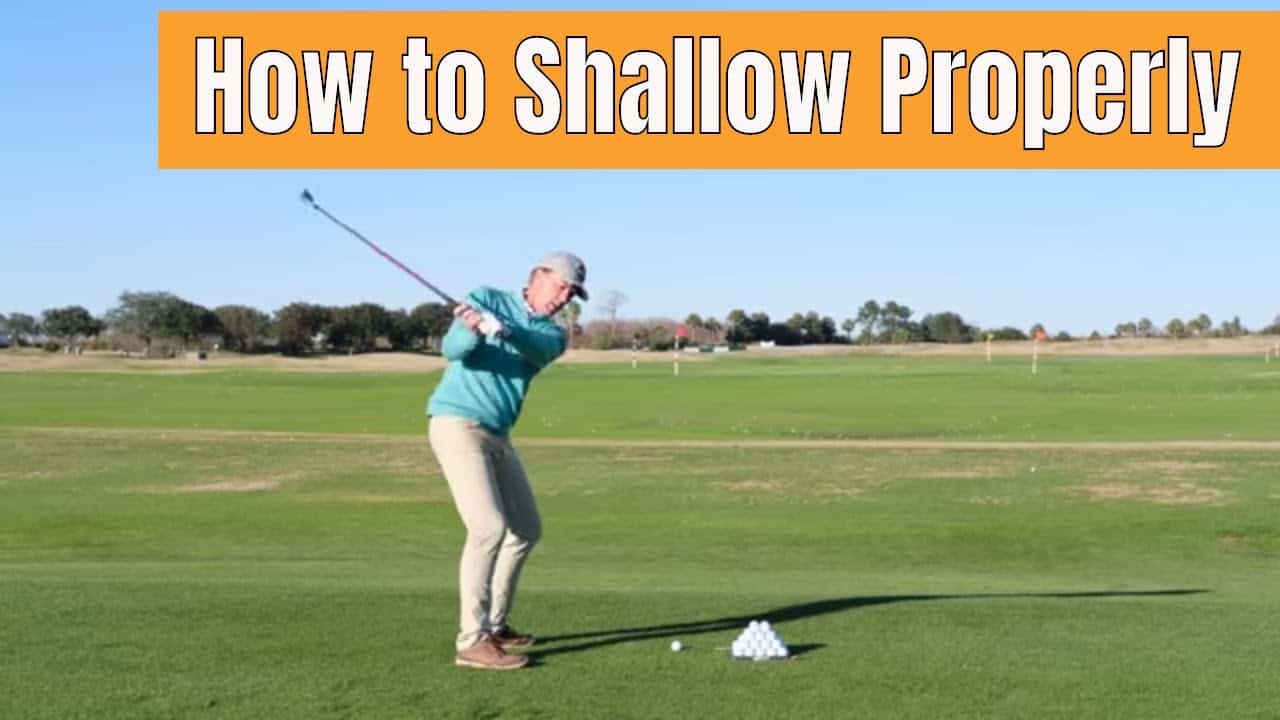Unlock Your Golf Potential: A Step-by-Step Guide On How to shallow the golf club
Key takeaway:
- Shallowing your golf swing can lead to improved ball striking and consistency.
- Learning the techniques used by PGA Tour pros can help you achieve a shallower swing.
- Understanding your swing sequence and finding the right technique for you are important steps in shallow your golf swing.
Introduction to Shallowing the Golf Club
Shallowing the golf club is a crucial concept that can greatly improve your golf swing. In this introduction, we will explore the fundamentals of this technique and how it can enhance your game. We’ll dive into the concept of shallowing and its impact on the golf ball’s trajectory and distance. So, if you’re looking to take your golf skills to the next level, understanding the art of shallowing the golf club is a must.

Understanding the Concept of Shallowing
Shallowing is an essential concept in golf. It helps improve swing technique. To shallow means to adjust the club’s steep angle for a shallower path on impact. This helps with accuracy and consistency. On the PGA Tour, pros use techniques for shallowing their swings. To understand one’s swing sequence is crucial to successfully implement shallowing techniques.
Explore resources to better understand how to shallow your swing. Shauheen Nakhjavani provides an 18-video series. Or try Skillest for virtual coaching. Common mistakes like “over-the-top” must be avoided. Integrate lower body, maintain wrist and clubface position, and master hip rotation.

Use tools to aid in shallowing. Tour Striker Plane Mate and Hosita Golf Swing Trainer can help with understanding body positioning. Troubleshoot and make adjustments. Common issues like slicing and pushing come from grip and lower body movement. Posture is important; stand tall for better performance.
Become a Jedi and master the art of shallowing your swing!
Benefits of Shallowing Your Golf Swing
Shallowing your golf swing can bring significant benefits to your game. From improved ball striking and consistency to exploring the techniques used by PGA Tour Pros, this section delves into the advantages of incorporating this technique into your golfing repertoire.
Improved Ball Striking and Consistency
Shallowing the golf club is a technique that can boost your golf swing. This means more accurate shots and greater control over your swings. Even PGA Tour pros use this technique, showing how powerful it can be. To get the most out of it, you must understand your swing sequence. And, by studying the pros, even if you find it tough to hit the ball straight, you can gain knowledge.
the Techniques Used by PGA Tour Pros
PGA Tour pros use various techniques to increase their performance and get consistent results. These methods have been studied to identify strategies which amateur golfers can use to better their game.
Such techniques include: enhanced ball striking, staying consistent, analyzing their swing sequences, and finding the right technique to suit their style. Hip rotation is also important for generating power and controlling the clubface for better accuracy and distance.
Amateurs can benefit from the knowledge of experienced pros by looking into the strategies used by PGA Tour pros. This can help them further understand the game and add these techniques to their training.
To help with this process, there are many resources available. These include training aids like Tour Striker Plane Mate and Hosita Golf Swing Trainer, and online coaching such as Shauheen Nakhjavani’s 18-video series and Skillest’s virtual coaching platform.
So don’t miss out! Take advantage of the opportunity to unlock the potential of a shallow golf swing. Discover and embrace the techniques employed by PGA Tour pros. Work hard and you’ll reach your full golfing potential.
Steps to Shallow Your Golf Swing
Improve your golf swing by mastering the art of shallow golf club. Learn the essential steps to cultivate a smooth, powerful swing sequence and discover the right technique tailored to your game. Get ready to enhance your performance on the green and achieve greater consistency and distance off the tee.

Understanding Your Swing Sequence
In golf, comprehending your swing sequence is essential. Comprehending the details of your swing sequence will give you greater control and consistency with your shots. This includes understanding the order and timing of movements from your setup to your follow-through.
Below is a 6-step guide to gain a deeper insight into your swing sequence:
- Analyze your setup position. Make sure you are aligned to the target and your posture is correct.
- Observe the takeaway phase. Pay attention to how you start the backswing and take the club away from the ball.
- Synchronize the movement of your arms, shoulders, and hips to make a smooth transition into the backswing.
- Pause for a moment at the top of your backswing to create proper sequencing between the backswing and downswing.
- Initiate the downswing with a weight transfer from your trail foot to your lead foot for more power and a solid strike on the ball.
- Finish your swing with a controlled follow-through. Maintain balance and extend through impact towards the target.
By analyzing your swing sequence, you can gain customized adjustments to optimize your performance on the course. Everyone has a unique swing sequence based on their body mechanics and capabilities. Experiment with what works best for you to get the most out of your technique. Finding the right technique is like finding a loyal caddie – it takes time and patience!
Finding the Right Technique for You
Finding the right technique for a shallow golf swing is key. Understand your swing sequence. Analyze it. Comprehend it. Find areas that need improvement and make adjustments. This knowledge helps you find the right technique.
Explore various methods used by PGA Tour pros. Study their approaches and learn from them. Experimenting with these techniques will help you find the one that fits your swing style and helps you achieve a more shallow club path.
Seeking expert guidance is beneficial to finding the right technique. Explore on your own, but seek additional resources for greater insights. The reference data mentions two resources – Shauheen Nakhjavani’s 18-video series and Skillest, a virtual coaching platform. These offer guidance from experienced instructors. They analyze your swing, give personalized feedback, and help you find the right technique. Highly recommended!
Common Mistakes to Avoid in the Shallowing Process
In the world of golf, the shallowing process is crucial for a successful swing. In this section, we will explore one common mistake to avoid: the dreaded “Over the Top” move. Discover the consequences of this error and how it can negatively impact your game. So, grab your clubs and let’s dive into how to perfect your shallow approach for a better, more consistent swing.

The “Over the Top” Move and Its Consequences
A swing technique, known as “Over the Top“, can be bad for a golfer. This move is when the club goes over the planned swing path. It leads to an outside-in motion and an open clubface at impact.
This causes poor ball striking and bad shot results. The open clubface leads to slicing and pulling shots. This brings down distance, accuracy, and control.
Golfers must stop the “Over the Top” move. They must use methods of the pros on the PGA Tour. This improves ball striking and more consistent results.
One way to stop it is to check your swing sequence. This means looking at how your body moves. Find any flaws and fix them.
Also, find the right technique for you. Use drills and exercises to make a shallow swing path. This should be an inside-out approach to impact. Keep an eye on weight shift, lower body use, wrist position, clubface control, and hip rotation.
Tools like Tour Striker Plane Mate and Hosita Golf Swing Trainer can help. They give advice and feedback in practice to make sure the mechanics are right.
Troubleshoot any issues that arise. Slicing and pushing shots can be caused by attempting to stop the “Over the Top” move. Find out why they occur and use the right solutions. This will help golfers have a consistent, powerful swing.
Drills and Techniques for Shallowing Out Your Swing
To improve your golf swing and achieve a more efficient impact, it’s essential to focus on drills and techniques that promote a shallower swing. In this section, we’ll explore how to accomplish this by honing your weight shift and engaging the lower body effectively.
We’ll also discuss the importance of wrist position and clubface control, as well as the role of proper hip rotation for generating power. By understanding and applying these fundamental aspects, you can elevate your golf game to a whole new level.
Weight Shift and Lower Body Involvement
Weight shift & lower body involvement are key to achieving a shallow golf swing. To get more power & consistency in your shots, you need to understand how to move your weight & engage your lower body. Here’s a 4-step guide:
- Start with a solid foundation: Feet shoulder-width apart. This allows even weight distribution during your swing.
- Begin the downswing with the lower body: Focus on moving your hips, legs & glutes. This helps transfer weight to your front foot.
- Maintain balance & stability: Head steady, proper posture & a stable base.
- Control your rotation in the follow-through: Keep your upper body aligned with the target line while rotating your lower body. This helps generate maximum power & a shallow club path at impact.
Practice these steps to improve your weight shift & lower body involvement. You’ll get a more powerful & consistent golf swing!
Wrist Position and Clubface Control
Wrist Position: Firm and neutral wrists are key for consistent ball striking. Excessive flipping or rolling of the clubface can lead to bad shots. Keeping control over the clubhead helps create a precise impact.
Clubface Control: Controlling the clubface is essential. Good clubface control lets golfers change the angle of the clubface at impact. This influences shot trajectory and spin. Draws or fades on demand give more versatility.
Alignment: Good wrist position and clubface control help with alignment. When wrists are correct at impact, the leading edge of the clubface is square to the target line. This leads to straighter shots with predictable ball flight.
Pro Tip: Alignment rods or training grips help with wrist position and clubface control. A golf instructor who specializes in swing mechanics can give valuable guidance to improve these aspects.
Proper Hip Rotation for Power Generation
Proper hip rotation is a must for maximum power in your golf swing. By rotating your hips properly, you’ll increase your clubhead speed and get extra distance. The correct technique means efficient energy transfer from your lower body to your upper body, resulting in more power. Follow these five steps to get the most out of your swing:
- Start with your feet shoulder-width apart and slightly turned out.
- On your backswing, turn your left hip away from the target while keeping your lower body stable.
- When you move into the downswing, rotate your right hip towards the target. This should come from the ground up for optimum power.
- At impact, make sure your hips are open to the target before you follow-through.
- Maintain balance and stability in your lower body throughout your swing.
Getting your hip rotation right not only boosts your power but also helps with accuracy. Put this fundamental into action and you’ll be sure to notice a difference. Remember though, it’s not just about hip rotation; wrist control and weight shift coordination are also essential for a great swing.
Did you know? Professional golfers have much faster hip rotational velocity than amateurs during their swings (Source: ‘1. Introduction to Shallowing the Golf Club’). Get the perfect swing with training aids and tools that will have you slicing in style!
Training Aids and Tools for Shallowing Your Swing
Discover two powerful training aids and tools that can help you achieve a smoother golf swing by focusing on shallowing your club. In this section, we’ll explore the Tour Striker Plane Mate and the Hosita Golf Swing Trainer.
These innovative devices have been designed to optimize your swing mechanics, improve your accuracy, and enhance your overall performance on the golf course. Get ready to take your game to the next level with these game-changing training tools.
Tour Striker Plane Mate
The Tour Striker Plane Mate is a revolutionary training aid for golfers. It helps improve swing mechanics and creates a shallow angle of attack. It provides feedback on wrist position to control the clubface. Plus, it emphasizes hip rotation to generate power in the swing.
It’s not just about correcting mistakes, either. It has user-friendly technology for any skill level. However, it won’t guarantee success instantly. Practice, technique, and understanding your swing are all important.
It’s endorsed by professional coaches and used by PGA Tour pros. For extra assistance, the Hosita Golf Swing Trainer is handy. But for overall effectiveness and enhancing your game, the Tour Striker Plane Mate is the best.
Hosita Golf Swing Trainer
The Hosita Golf Swing Trainer is a great training aid, giving real-time feedback on swing mechanics. It’s designed to improve swing mechanics and enhance performance on the course.
This tool has adjustable resistance settings, making it easier for golfers to build strength and power in their swing. This means they can increase clubhead speed and generate greater distance off the tee.
It also has other benefits, such as encouraging a balanced weight transfer, proper hip rotation, and optimal wrist position for better control of the clubface.
The Hosita Golf Swing Trainer is compact and easy to transport, so you can use it at home or on the practice range. Plus, its durable construction ensures long-lasting performance.
This training aid covers various aspects of the golf swing. It focuses on developing a shallow club path through impact – a crucial skill for consistent ball striking and eliminating slicing tendencies.
By using the Hosita Golf Swing Trainer, you can fine-tune your swing mechanics and improve your game. Whether you’re a beginner or an experienced player, it’s a valuable tool for your journey.
Having a reliable and effective training aid like the Hosita Golf Swing Trainer is essential for every golfer. It’s like playing a round of golf with a blindfold off – no more surprises!
Troubleshooting and Adjustments
Whether you’ve been struggling with slicing and pushing shots or you’re curious about the impact of standing tall on your swing mechanics, this section is here to help. We’ll explore the causes and solutions to common slicing and pushing issues, as well as the significance of maintaining the right posture in your golf swing. So, get ready to troubleshoot and make the necessary adjustments to improve your game on the course.
Slicing and Pushing – Causes and Solutions
Slicing and pushing are big no-nos for golfers aiming for accuracy and consistency in their ball striking. To improve your game, it’s essential to identify the causes and find solutions.
Visualize! You need a clear image in your mind of the desired ball flight. Think of a gentle draw or a straight shot, not a slice or push. Let this mental image guide your swing adjustments.
Grip matters! Your grip has a major role in the clubface position at impact. A strong grip could cause slicing, while a weak one can lead to pushing shots. Try out different grips until you find one that gives you a square clubface at impact.
Path is key! The path of the clubhead during the downswing can make or break your ball flight. Slicers tend to go over-the-top, causing side-spin and slicing shots. Pushers come from the inside-out, sending shots to the right (for right-handed golfers). Aim for a more neutral path that promotes straighter shots.
Rotation counts! Body rotation is essential for generating power and controlling the clubface. Hip rotation should initiate the downswing movement, resulting in an inside-to-square-to-inside path that reduces slicing or pushing tendencies.
These steps can help you reduce slicing and pushing, but you’ll also need to be aware of any unique details specific to your swing mechanics that might be contributing. Consider weight distribution, shoulder alignment, and other factors. It’s best to get professional guidance to ensure proper technique and long-term improvement.
Pro Tip: Be consistent! Gradually incorporate any changes and don’t be a toddler on a sugar rush.
Standing Tall and Its Impact on Swing Mechanics
Proper posture is essential for great golf performance. Upright stance affects swing mechanics such as clubhead speed, angle of attack, and ball contact. Standing tall lets you transfer energy from your body to clubhead more efficiently. This leads to greater clubhead speed and distance. Also, an upright posture promotes a shallow swing path, reducing the risk of slicing or hooking the ball.
Plus, standing tall impacts the angle of attack. This allows for a steeper angle of attack, resulting in clean ball contact and preventing chunked or topped shots.
To maintain proper posture, keep spine straight and knees flexed. Avoid hunching over or standing too erect as this can reduce power and accuracy.
In conclusion, standing tall is key to maximizing swing mechanics and golf performance. By keeping an upright posture throughout the swing, you can optimize clubhead speed, improve angle of attack, and have consistent ball contact.
Pro Tip: When practicing, check in a mirror or record yourself from different angles. This will help you identify any incorrect posture or hunching that could be damaging your swing mechanics.
Conclusion – Unlocking the Power and Consistency of a Shallow Golf Swing
Unlocking the power of a shallow golf swing can help golfers improve their game. Shallowing the club involves a correct swing plane and movements that follow in a coordinated way.
Maintaining a proper swing plane is essential. This means the club travels parallel to the target line during the downswing. It requires body rotation, arm positioning, and wrist hinge.
Sequencing of movements is another key element. Begin the downswing with a rotation of the hips and lower body. Then, the arms and hands should follow in a synchronized manner. This will allow the club to release through impact with maximum power and consistency.
A shallow golf swing requires practice and dedication to master. Professional golfers spend hours honing their technique and perfecting their swing. By incorporating the techniques of a shallow swing into their practice routine, golfers can unlock the power and consistency that comes with a shallow swing.
Golf Digest conducted a study which found golfers who achieved a shallow swing saw improvements in their game. They could hit the ball farther with increased accuracy and control. Unlocking the power and consistency of a shallow swing can take a golfer’s game to the next level.
A shallow golf swing is worth striving for. Incorporate proper swing plane, sequencing of movements, and dedicated practice to unlock the potential of a game. Enjoy improved distance, accuracy, and control.
Some Facts About How To Shallow The Golf Club:
- ✅ Shallowing your golf swing can improve ball striking and consistency. (Source: Skillest.com)
- ✅ Shallowing refers to getting the club into a more horizontal position during the downswing. (Source: Skillest.com)
- ✅ PGA Tour pros have the same swing plane on the downswing, regardless of their backswings. (Source: Skillest.com)
- ✅ Shauheen Nakhjavani has created an 18-video series on shallowing the golf swing. (Source: Skillest.com)
- ✅ Shallowing your swing leads to more consistent contact, longer drives, and more compression on irons and wedges. (Source: Skillest.com)
FAQs about How To Shallow The Golf Club
How can I shallow my golf swing?
To shallow your golf swing, you can try the following techniques:
- Softening your right arm to increase flexibility during the backswing
- Moving your hands inward instead of taking the clubhead straight back
- Maximizing hip rotation to generate power and guide the swing through the shot
- Shallowing the shaft at the top of the downswing through proper hip rotation
- Tilting your trail leg towards the front leg during the downswing to initiate a powerful leg drive
What is the wall drill for shallowing the golf swing?
The wall drill is a technique to help shallow your golf swing. It involves setting up with your back against a wall and ensuring that the club does not touch the wall on the backswing and downswing. By using hip rotation, a soft right arm, and moving your hands inward, you can practice maintaining the correct clubhead position and shallow the swing.
How can the Trail Side Tilt help me shallow my golf swing?
The Trail Side Tilt is a technique that involves tilting your trail side (right side for right-handed golfers) towards the front during the downswing. This motion helps initiate a powerful leg drive and achieve the correct clubhead position at impact, contributing to a shallower golf swing.
What are the ball flight expectations when I shallow my golf swing?
When you successfully shallow your golf swing, you can expect to see improved ball striking, more consistent contact, and increased distance. Shallowing the swing can also help you hit crisp iron shots and achieve a draw ball flight.
Which professional golfers are known for their shallow golf swings?
Golfers like Dustin Johnson, Collin Morikawa, and Rickie Fowler are known for their shallow golf swings. Watching videos of these ranked PGA Tour players can provide visual guidance and inspiration for achieving a shallower swing.
Are there any specific drills or training aids that can help me shallow my golf swing?
Yes, there are drills and training aids that can assist in shallowing your golf swing. The half swing drill involves stopping at the halfway point of the backswing, lowering the club slightly, and rotating the hips while squaring the clubface at impact. The wall drill, as mentioned earlier, helps you maintain the correct clubhead position. Additionally, training aids like the Tour Striker Plane Mate and the Hosita Golf Swing Trainer can provide feedback and promote proper swing mechanics.




![Unlocking the Secret to Choosing the Best Golf Drivers for Mid Handicappers [2024]](https://www.fairwayfindings.com/wp-content/uploads/2024/03/Choosing-the-Best-Golf-Drivers-for-Mid-Handicappers-768x768.webp)


